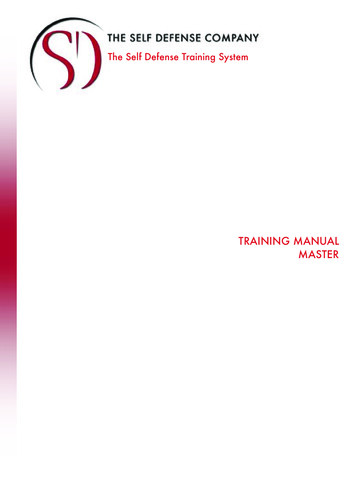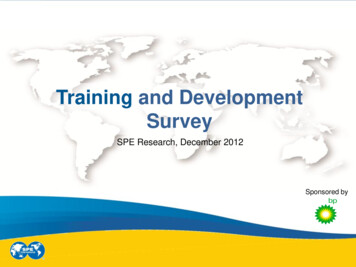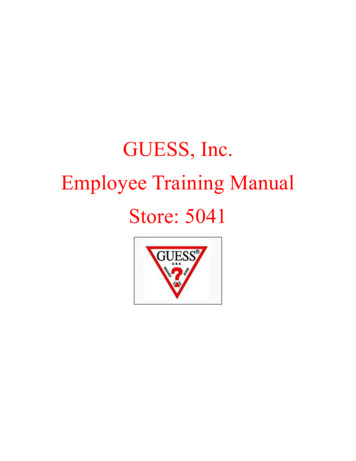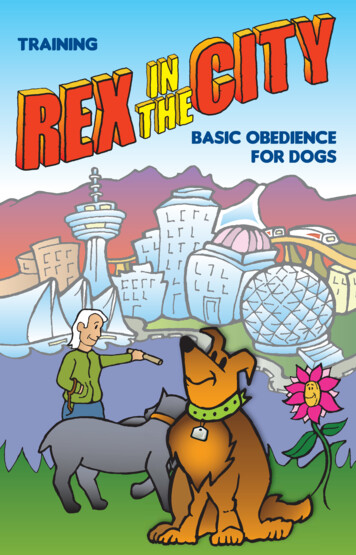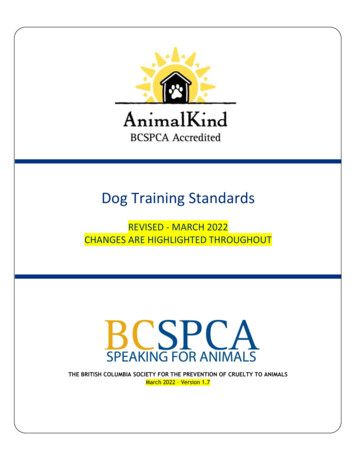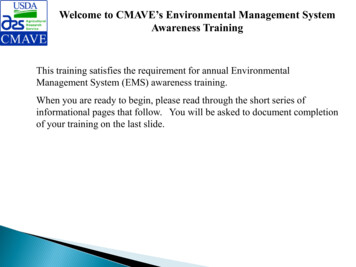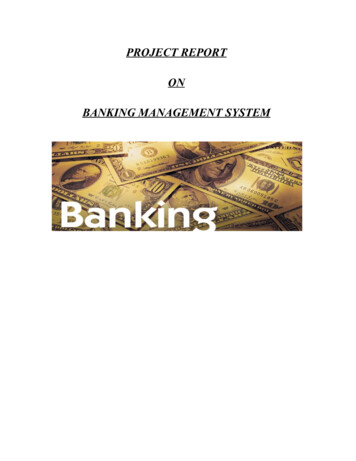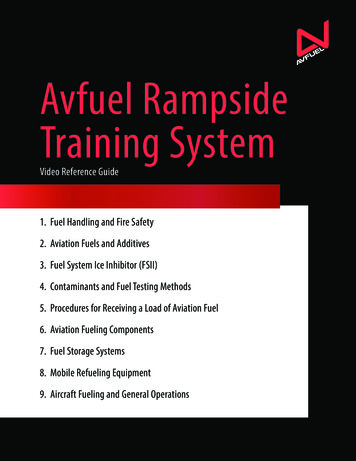
Transcription
Avfuel RampsideTraining SystemVideo Reference Guide1. Fuel Handling and Fire Safety2. Aviation Fuels and Additives3. Fuel System Ice Inhibitor (FSII)4. Contaminants and Fuel Testing Methods5. Procedures for Receiving a Load of Aviation Fuel6. Aviation Fueling Components7. Fuel Storage Systems8. Mobile Refueling Equipment9. Aircraft Fueling and General Operations
Table of Contents33445679Fuel handling and fire safetyMaterial Safety Data Sheets (SDS)Personal protective equipment (PPE) needed when handling fuelFire propertiesFlash point, autoignition, net heat of combustionFire ClassesExtinguishing agentsFire safety proceduresBasic procedures for spill prevention and controlAVIATION fuels and additives15 How aviation fuels are refined and distributed15 Turbine Fuel & Aviation Gasoline17 Aviation Approved AdditivesFuel system icing inhibitor (FSII)Familiarizeyou with FSII, how it works and clear up misconcep2121 tions regarding the product23 How to use a test kit for inspecting correct quantities of FSIIStorage and handling essentials, such as “Injection Dos and Don’ts”2727282828292931323337contaminants and fuel testing methodsWaterSolidsSurfactantsMicroorganismsCross contaminationClear and bright testWhite bucket testHydrokit testAPI Gravity testColorimetric testSumping3941454444Procedures for Receiving a Load of Aviation FuelProduct Receipt Documentation and PaperworkProcedures to follow prior to receiving a transport loadHow to Inspect a transport load and test for fuel qualityProcedures for Unloading a Transport loadProcedures to follow After Unloading a Transport loadAVIATION FUELING COMPONENTS49 Bonding components and correct bonding techniques49 Filter vessels and elements - specifically filter/separatorsand filter monitors51 Water defense systems52 Pressure gauges52 Pumps53 Hoses53 Nozzles54 Meters, and54 FSII Injection systemsFuel storage systems59 Fuel transfer to and from storage tanks60 Fuel-storage system components, safety features andinspection procedures696971727387888888898989Mobile Refueling EquipmentSafe maneuvering of a refueling truckOverwing fuel transfersUnderwing fuel transfers pg 71Fuel transfers between fuel storage systems and refueler trucksMobile refueler truck components and inspection proceduresAircraft Fueling and General OperationsTaking a fuel orderPrevention of misfuelingFSII ordersSpecial Fueling SituationsFueling with passengers on board“Hot” fuelingDefuelingThunderstorms and lightning
Fuel handlingand fire safetyAviation fuels and their additives are hazardous materials. It’s critical that your staff undergo professional safety training. In this section on fuel safety, we’ll review Safety DataSheets (SDS), personal protective equipment (PPE), fire properties, fire safety procedures,and basic procedures for spill prevention and control. QA Reference Guides mcp 5.7.14.indd 1Material Safety Data Sheets (SDS) pg 3Personal protective equipment (PPE) needed when handling fuel pg 3Fire properties pg 4 Flash point, autoignition, net heat of combustion pg 4 Fire Classes pg 5 Extinguishing agents pg 6Fire safety procedures pg 7Basic procedures for spill prevention and control pg 95/7/14 12:59 PM
page 2QA Reference Guides mcp 5.7.14.indd 25/7/14 12:59 PM
Fuel handling and Fire safetysafety data sheets, or sdss, outline procedures for handling substances in a safe manner. the Occupational safety and health administration(or Osha) requires that all staff and emergency personnel review these documents prior to handling aviation fuel products. Osha alsorequires that Msdss for products handled by your FBO be made available to all employees at your location as well as to local fire departmentsand local and state emergency planning officials. “avfuel provides sdss along with all of our fuel products.”INFORMATION FOUND IN AN SDS DOCUMENT INCLUDES: Chemical Product and Company informationComposition and information regarding ingredientshazards identification,First aid Measures,Fire Fighting Measures,accidental release Measures,handling, storage, exposure Controls and Personal Protection,Physical and Chemical Properties,stability and reactivity,ecological information,disposal Considerationstransport information and regulatory informationall safety and personal protection recommendations included on each product’s sds must be implemented at your location.aviation fuels are highly flammable and may contain toxic additives that should not come into contact with skin. these fuels must be handledwith extreme care and caution.Be on alert for additives including fuel system ice inhibitor (Fsii) additive in turbine fuel or lead or tel in avgas 100ll.Personal protective equipment, commonly referred to by the abbreviation PPe, should always be used when handling aviation fuel. PPeincludes: Gloves , Safety glasses or goggles, Non static-generating clothing, and leather shoes without exposed metal toes or tapsit is your responsibility to use the correct PPe for the products you are handling. Consult each product’s sds for guidance.understanding the behavior of fire and how to extinguish it, as well as recognizing possible ignition sources helps prevent property damageand injuries. in the event of a fire, immediately call the fire department responsible for the air field regardless of whether or not you have useda fire extinguisher -- or succeeded in extinguishing the fire. the fire department can assess the situation and extinguish fires that may be outof your control. they have been trained to prevent fires from flaring up again. Always check with the Authority Having Jurisdiction orAHJ for any additional or special requirements for your location.the national Fire Protection agency or nFPa is the world’s leading advocate of fire prevention and an authority on public safety. the nFPadevelops and publishes, more than 300 codes and standards designed to minimize the possibility and harmful effects of fire.page 3QA Reference Guides mcp 5.7.14.indd 35/7/14 12:59 PM
Fuel handling and Fire safetytwo relevant fire safety publications often referred to are nFPa 30 and nFPa 407. these are commonly used in the management of aviation fuelstorage facilities and fueling equipment.NFPA 30 defines safeguards for the storage, handling, and application of flammable and combustible liquids. it also defines safety measuresfor fuel farm and storage construction.NFPA 407 pertains to aircraft fuel service. it establishes reasonable minimum fire safety standards for the protection of people, aircraft, andproperty during the aircraft-fueling process at airports.the Faa requires that airports with a Part 139 Certificate adhere to the standards put forth in both nFPa 30 and nFPa 407. it actuallyrecommends that all airports, whatever their type, adopt these standards. these key publications are also endorsed by the nata, ata, aPi, andall major fuel suppliers.avfuel Corporation recommends that you have copies of both publications available for reference at your location at all times.the ability to identify potential fire hazards in fuel handling is critical. let’s review the properties and risks associated with Jet-a and avgas.the Flash Point of a liquid refers to the lowest temperature at which an ignitable mixture of the liquid and air near its surface can form. thelower the flash point, the easier it is to ignite the material.the flash point for Jet-a is 100 degrees Fahrenheit and its flammability is Class ii. Class ii means that the material must be moderately heatedor exposed to relatively high temperatures before it will ignite.the flash point for avgas is -50 degrees Fahrenheit and its flammability is a Class iii. the term Class iii applies to liquids and solids that canignite under almost all temperature conditions.”Flammability” Conditions refers to the ratio of fuel vapor to oxygen for combustion to take place. there is a lower and upper limit to a safe,non-flammable condition: When the fuel/air mixture falls below the lower limit, the mixture is “too lean” – and there is no danger of ignition.When the fuel/air mixture exceeds the upper limit, the fuel/air mixture is too rich and will not ignite. Jet-a 0.74%-5.32% avgas 1.4%-7.6%AUTOIGNITION IS THE TEMPERATURE AT OR ABOVE WHICH A SUBSTANCE WILL IGNITEWITHOUT ANY OUTSIDE IGNITION SOURCE AT ALL. the autoignition temperature for Jet-a is 475 degrees Fahrenheitthe autoignition temperature for avgas is 840 degrees FahrenheitBut taKe CautiOn: heat sources like engine exhaust,hot brakes, or bare light bulbs may be below the auto-ignition temperature and stillignite a fire! it is important that fuel not be spilled on any of these or similar heat sources. regular inspection of all equipment, particularlyprotective and insulating devices such as light bulb lenses and muffler shields should be conducted frequently.page 4QA Reference Guides mcp 5.7.14.indd 45/7/14 12:59 PM
Fuel handling and Fire safetythe rate of Flame spread is the speed at which flames travel across the surface of a body of fuel. as the fire burns, the layer of fuel closestto the top begins to separate. Oxygen is present in varying concentrations and allows the fuel to vaporize in the necessary concentrationsto allow flame production. as this occurs, flame spreads. the leading edge is called the flame front.the “net heat of Combustion” is the amount of heat energy released by combustion per volume of fuel.THE NET HEAT OF COMBUSTION OF avgas is 19,000 Btu/lbJet-a 18,600 Btu/lbthe fire tetrahedron refers to the four conditions that must be present for fire to take place: heat is needed to raise the material to itsignition temperature, causing the fuel or combustible material to ignite and a subsequentChemical chain reaction to occur. Oxygen thensustains combustion. this was originally called a “triangle” until a fourth element was added.TO SUCCESSFULLY EXTINGUISH A FIRE, ONE COMPONENT OR SIDE OF THIS“TETRAHEDRON” MUST BE ELIMINATED. removing the fuel source will starve a fire.removing heat can prevent a fire from taking place or stop a fire in progress.stopping the chemical reaction that feeds the fire will also starve a fire.removing oxygen will smother the fire.Fire extinguishers put out fires by taking away one or more of these elements.We divide types of fire into five classes – a,B,C,d and K. this classification identifies different characteristics of fires to help you determinewhat methods and agents should be used to extinguish a fire.Class A fires involve common combustible materials such as wood, cloth, paper, rubber and some plastics.EXAMPLE: A wildfireClass B fires involve flammable and combustible liquids, greases, and gases.EXAMPLE: A Jet-A fire”Class C fires” involve energized electrical circuits.Class C fires are started by a short circuits or high voltage sources.EXAMPLE: Downed power line or an electrical fire on an aircraft refueler chassis.Class D fires involve combustible metals such as magnesium, titanium, zirconium, and sodium.EXAMPLE:In aviation, Class D fires occur due to Titanium and Magnesium alloys, often used in aircraftconstruction by virtue of their considerable strength-to-weight-ratios.Class K fires involve cooking oils or fats found in kitchen fires.page 5QA Reference Guides mcp 5.7.14.indd 55/7/14 12:59 PM
Fuel handling and Fire safetyWHY DO YOU NEED TO KNOW ALL THIS?it is critical to how you extinguish or prevent a fire. even your fire extinguishers must be of the appropriate type to the class of fire. therefore allextinguishers on your ramp and around a given aircraft should be designed for Class B and C fires. there are certain extinguishing materials youmust not use on aircraft because they can damage the aircraft or the environment. halon, for example, should be avoided due to environmentalconcerns. the best bet is to stay informed:Check with your local fire marshal frequently for the proper type of extinguishing equipment required at your facility.Perform daily checks to ensure that extinguishers are visible and offer unobstructed access. Check any gauges frequently. if the extinguisher’sseal is broken, or if there is any indication of a low charge, you should service that extinguisher or discard it using your facility’s accepteddisposal protocol. Perform monthly checks of fire-extinguishers to ensure that inspection tag dates are current, charges are full, and that sealsand pins are in place. Be aware that extinguishers must be stored away from ice and snow. any covers in place to prevent ice and snow fromaccumulating must be removed by your personnel during aircraft fueling for quick emergency access.your local authority having Jurisdiction (ahJ) is authorized to dictate changes to your storage and inspection process at any time. alwaysfollow your local ahJ directives -- it could save a life.as we have mentioned, there are many types of fire extinguishers. these contain different extinguishing agents. some extinguishers are onlyeffective on certain classes of fires. read extinguisher labels carefully to determine what class of fire they are designed to extinguish.LET’S DISCUSS SOME COMMON EXTINGUISHING AGENTS:”Water” - Water is most effective at extinguishing Class a fires. it quenches and cools the fire, removing the heat component of the firetetrahedron. however it is not effective for class B, C, or d fires. indeed, it can be a hazard: extra caution should be used to prevent water frombeing sprayed on energized electrical fires. the water can become a conductor, shocking personnel. Furthermore when used on a flammableliquid like avgas, water can spread the fire.CO2 - When it comes to fires, we call carbon dioxide or CO2 a smothering agent. it extinguishes fires by displacing the oxygen necessary tosupport combustion and is most useful against Class B and C fires. Because CO2 is a pressurized gas, it will readily disperse in windy conditions.this means it must be used at close range. unfortunately CO2 is an asphyxiant and can be toxic in an enclosed area, so care must be taken byits user. it is neither corrosive nor conductive, and it discharges rapidly and leaves no residue.Dry Chem - dry chem refers to a dry chemical agent stored in a pressurized container and consisting of sodium bicarbonate (also known asbaking soda), potassium Bicarbonate, or monoammonium phosphate. these solids are inert, or nonreactive and work by removing the oxygenside of the fire tetrahedron. they also interfere with the chemical chain reaction. dry chem is typically used on Class B or C fires.another kind of dry chem extinguisher containing mono-ammonium phosphate may be used for fighting Class a fires. ButMonoammonium Phosphate is corrosive to aircraft materials and is restricted on the airport ramp per nFPa 407.Foam - Foams contain a blend of bicarbonate of soda and aluminum sulfate. true to their name, this combination foams when mixed withwater. Foams are effective blankets that cool and smother a fire. Foam is very effective against class B fires and is effective -- to a degree -against Class a fires. Foam does not work well on vertical surfaces as it will not cling sufficiently. it is also not effective against fires that arefed under pressure, as the pressure inhibits the foam’s abilities.page 6QA Reference Guides mcp 5.7.14.indd 65/7/14 12:59 PM
Fuel handling and Fire safetyHalon - halon interrupts the chemical chain reaction needed to produce fire by preventing fuel and O2 from combining. halon leaves noresidue but it is an asphyxiant and must be used with care. While halon is useful in fighting both Class B and C fires, it has a negativeenvironmental impact and should be avoided.the nFPa requires fuel service personnel to be thoroughly trained in the use of available fire extinguishing equipment. Check with your ahJ orlocal fire station for hands-on training opportunities. Most professional fire fighters will be happy to work with you in creating a safe, fire-freeenvironment.you know how to identify the correct fire extinguisher. now how do you work it? an effective way to remember is with the acronym PASS.P-ull- the safety pinA-iM- the nozzleS-QueeZe- the triggerS-WeeP -the base of the fireCONSIDER THE FOLLOWING WHEN DECIDING WHETHER OR NOT TO USE A FIRE EXTINGUISHER: is the extinguisher located in an appropriate and non-hazardous location?is it in working order?is the fire extinguisher of the proper type for the fire under consideration?is the fire small enough to put out with a fire extinguisher?has the fire been discovered by a person ready, willing, and properly trained and capable of using the extinguisher?HERE ARE SOME MORE SAFETY CONSIDERATIONS: is there any possibility of explosion?Could your escape route be cut off?Can you completely extinguish the fire?Could it rage beyond your ability to contain it before it can be put out completely?how fast can the fire department respond?never turn your back on a fire, even if you think it has been extinguished. there may be enough heat left to cause a deadly flashback. Post avigilant, informed guard in a safe place near the extinguished fire’s location until authorities arrive to assess the situation.eliminating possible ignition sources and preempting fire-friendly conditions -- such as fumes -- is your first line of defense against fires andexplosions.avoid open containers, and be wary of fuel spills or any situation where fuel is exposed to air. these can all enable the formation of a flammablefuel/air mixture.page 7QA Reference Guides mcp 5.7.14.indd 75/7/14 12:59 PM
Fuel handling and Fire safetydo not ever use leaking equipment. repair faulty equipment immediately, and clean up even the tiniest fuel spills the instant they occur.take care to dispose of test fuel and spill-cleanup material correctly to reduce potentially hazardous conditions at your fueling facility. Correcthandling will be dictated by your local fire authority and your facility.Always be alert for potential ignition sources and remove them immediately from your fueling and fuel storage areas. it’s notworth the risk. this list is not comprehensive. static electricity and sparks near a fuel source.this includes clothing that has the potential to produce static. For example, polyesteris especially prone to static and should be avoided entirely.Plastic or galvanized fuel buckets also generate static and should not be used unless modified with bonding equipment.electronic devices: these devices include but are not limited to iPods, radios, MP3 players, cellular phones, and gaming systems. Onlyuse electronic devices that have been officially approved for use near fuel vapors.Matches or lighters: these are strictly prohibited and may not be carried by refueling personnel.unshielded electrical equipment such as open junction boxes, switches, conduit, bare wires, or bare light bulbs.Failure to bond – a high differential charges can develop when bonding isn’t performed correctly or at all. We will discuss the processand dangers of Bonding in more detail later in your training.Fuel itself can be charged -- with most of the charge carried at its surface. this can happen when splash-loading creates static as fueldrops into a tank. aircraft brakes reach their peak temperatures up to 30 minutes after hard braking. do not assume that a parkedaircraft’s brakes aren’t hot enough to start a fire.exhaust and hot engines - are common igniters as we have mentioned. take care with vehicles of all types.Static Charge is an unmoving electrical charge. it can be caused by friction between dissimilar materials. When two materials rub againstone another the electrons of one material are deposited onto the other material, leaving the first with a positive charge and the second with anegative charge caused by the new surplus of electrons.the more aggressive the rubbing, the more electrons are transferred to the other material. the more electrons that transfer, the more powerfulthe static charge.static transfer takes place in many areas of a fueling facility. the prime culprit is the filter vessel in the aviation fuel system itself. as fuelpasses through the filter media the resulting friction produces an enormous amount of static. this is regardless of whether the system uses astandard coalescer/separator, a water-monitor element or a simple micronic unit. Fuel tends to store the majority of charge at its surface. toavoid ignition, filter vessels must be filled slowly, so that air can be purged through the air-eliminator especially after changing filters.Positive and negative static charges ”want” to be balanced or neutral. unless safe pathways are provided, they may jump or arc to anothermaterial to regain a neutral state. these jumps are an ignition source. an example of “arcing” is the mild shock you get after shuffling yoursocked feet across a carpet and then reaching for a doorknob or light switch. the charge created by your feet simply jumps through the spacebetween your finger and the surface.In aviation, for example: A landing aircraft’s fuselage could acquire a charge created by its movement through air; Meanwhile, a refueler truckmight generate an opposite charge as it moves along its ramp. Now we have the potential for a spark -- when the aircraft and truck are positionedfor fueling, a spark might arc between the fuel nozzle and the fuselage. To prevent this spark, bonding is necessary. Bonding must occur betweenthe refueler and the aircraft before the fuel cap is removed and before you approach with a nozzle. Bonding opens an escape pathway for thepage 8QA Reference Guides mcp 5.7.14.indd 85/7/14 12:59 PM
Fuel handling and Fire safetycharges to equalize so that they don’t produce a spark and create a fire.Bonding is the creation of an electrical path between two objects as a means of safely exchanging any charges. It makes twoseparate objects unify as one – electrically speaking.the bonding process works by purging or returning excess electrons that have transferred from one item to another (say the ramp to the fueltruck) back to their point of origin, or to a safe alternative. Bonding reduces the electrical potential between the two pieces of equipment,thereby reducing the likelihood of a static discharge or spark.nFPa 407 requires that you have a method for bonding equipment during fuel transfer. From transport to farm, from farm to refueler, andfrom refueler to aircraft there must be the ability to form electrical bonds. nFPa also requires that bonding equipment be less than 25 ohmsresistance.this bond must be made before any fueling operation is conducted. additionally bonding of over wing nozzles is mandatory per the nFPa.nFPa also requires a strict non-smoking rule in all fueling areas. no smoking signs should be posted at all fueling area entrances, and all staffmust be educated in the clear and present dangers of smoking. Finally a no smoking sign must be prominently displayed in the cab of everyaircraft fuel servicing vehicle.every employee is prohibited from carrying matches, lighters, or any other ignition sources near aircraft or at fueling locations. lighters andashtrays must be removed or disabled on refueling equipment.Spills:a spill is one of the most dangerous situations that can occur on the airport ramp because of its potential to lead to fire or explosion.THE FIRST THING TO REMEMBER REGARDING SPILLS IS THIS:the safety of employees, pilots, and anyone within proximity of the ramp or spill area is of paramount importance.Be proactive when it comes to spills. Create detailed, thorough plans for managing spills of any size. Of course, having the appropriate spillequipment in place at each fueling location is a critical part of any plan, as is ongoing training of your staff.all airport fueling operations are required to create and enforce a written spill plan -- and also to practice it regularly with staff. every planshould take into account all personnel shifts to ensure that it can and will be executed any time of day.Failure occurs most frequently in spill plans when there is a lack of training. avoid this pitfall by creating (and enforcing) an education andpractice drill schedule for your employees.let’s discuss these plans in more detail. Written spill prevention plans are typically required by state and/or federal authorities. We refer tothese written spill plans as spill Prevention, Control and Countermeasures (sPCC).page 9QA Reference Guides mcp 5.7.14.indd 95/7/14 12:59 PM
Fuel handling and Fire safetyyour plan must be engineered for your unique location, and must encompass all storage and distribution equipment used for bulk petroleumproducts. these plans are typically written by a certified engineer in your state or region to prevent and control the release of oil products(including aviation fuels) into navigable waters. “navigable Waters” actually refer to any source water that can run-off into a body of water likea lake, river, stream or reservoir this can include storm water run-off ditches and drains.nFPa 407 has several recommendations for handling spills and leaks. each spill must be evaluated based on its size, the type of flammablesubstance involved, the current weather conditions, the arrangement or proximity of equipment, and the personnel available.A GOOD SPILL PLAN INCLUDES BASIC RESPONSE PROTOCOLS LIKE THESE: evaluate whether the situation is safe. is it safe to try to mitigate the spill?if possible stop the spill at its source.evacuate passengers from aircraft if necessarynotify the airport fire response authority and/or your supervisornever start or move equipment unless instructed to do so by the ahJPosition an extinguisher upwind of the spillPost a guard and direct traffic away from the areause spill-handling equipment and materials to restrict the spill as much as possiblePrevent any of the spill from reaching storm water drains and natural ground areas like grass and soil if possiblesite-specific spill clean-up equipment should be available at each and every fueling location. all mobile equipment and any storage ordispensing locations should be equipped with its own emergency spill kit. the size of each spill kit and materials found within it depends uponthe location and type of fueling performed at each site. For example, a large storage location that loads mobile refuelers at 300 gallons perminute may require a larger volume of cleanup material than that of an avgas refueler loading at only 20 gallons per minute.Maintaining fully stocked spill kits at all times is critical to safety. integrate checks with your daily inspections. When you or your staff use aspill-pad to mop up a leak from a dripping nozzle, make sure you replace it immediately! Be proactive and add a schedule of checking andrestocking spill-kits to your official spill plan.A STANDARD MOBILE REFUELER SPILL KIT CONTAINS: several absorbent containment socks to direct flow or contain a spillmultiple absorbent pads for smaller leaks and spills,a loose absorbent substance that can be scattered onto a spill,a pillow to absorb large spillsa set of protective gloves for personnel.KITS FOR FUEL STORAGE SYSTEMS:these require larger supplies of clean-up material. these larger kits are more comprehensive and may contain spill-safe brooms, spark-proofshovels, safety cones, waste-collection drums , or specialty spill vacuums to suck away large amounts of fuel from the ramp. no matter whatyour spill kit or kits consist of, always keep them stocked and available for emergency use.page 10QA Reference Guides mcp 5.7.14.indd 105/7/14 12:59 PM
Fuel handling and Fire safetylearning and following basic procedures are important to the safety of you and your staff. here are additional guidelines for handling aviationfuels and related products. never mix jet fuel and avgasdo not use common piping or tanks for aviation fuels and related products. Furthermore, label all pipes and storage tanks with theproduct and grade.eliminate any possible source of ignitionCorrectly and safely dispose of fuel-soaked rags and absorbent materialMake sure all fire extinguishers are of the proper type, are charged, and readily positioned for useWhen handling chemicals, avoid prolonged contact with skin. rinse exposed areas generously with soap and waterKnow where your eye wash station is located and how to use itremove any and all exposed clothing and wash thoroughly or dispose of correctly.page 11QA Reference Guides mcp 5.7.14.indd 115/7/14 12:59 PM
general Fuel handling and Fire safetypage 12QA Reference Guides mcp 5.7.14.indd 125/7/14 12:59 PM
aViatiOn Fuels and additiVesthis course reviews the following: how aviation fuels are refined and distributed, the typesof aviation fuels currently being used, specifications those fuels are refined to, and the useof aviation approved additives. how aviation fuels are refined and distributed pg 15turbine Fuel & aviation gasoline pg 15aviation approved additives pg 17page 13QA Reference Guides mcp 5.7.14.indd 135/7/14 12:59 PM
Fuels and additivespage 14QA Reference Guides mcp 5.7.14.indd 145/7/14 12:59 PM
aviation Fuels and additivesaircraft are powered by liquid petroleum fuels. liquid fuels have higher energy contents per unit volume than gases, and are easier to handleand distribute than solid fuels. among liquids, liquid hydrocarbons offer the best combination of energy content, availability and price. aviationfuels are primarily made from refined crude oil. Crude oil is taken from a collection point and moved by truck, pipeline or barge to a refinery,where it is stored until moved to a distillation column where it is heated until it boils. during the distillation process the crude oil’s molecularstructure changes. the crude is heated, and as the molecular structure changes, evaporating vapors rise and are cooled inside the column andthen collected through different side draws or trays. each distilled petroleum product has an initial boiling poi
Training System Video Reference Guide. FuEL HAndLInG And FIRE SAFETy Material Safety data Sheets (SdS) Personal protective equipment (PPE) needed when handling fuel Fire properties Flash point, autoignition, net heat of combustion . ignite a fire! it is important that fuel not be spi
